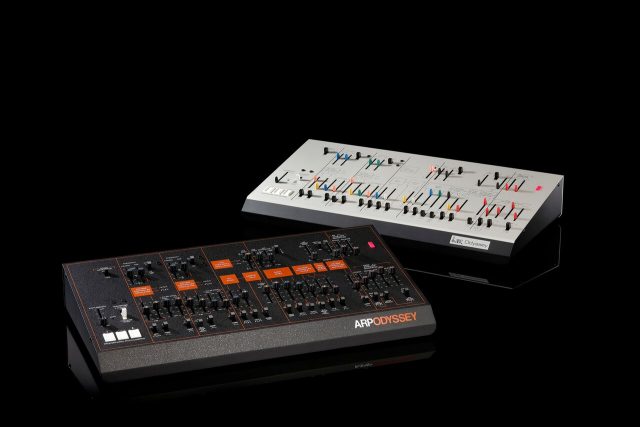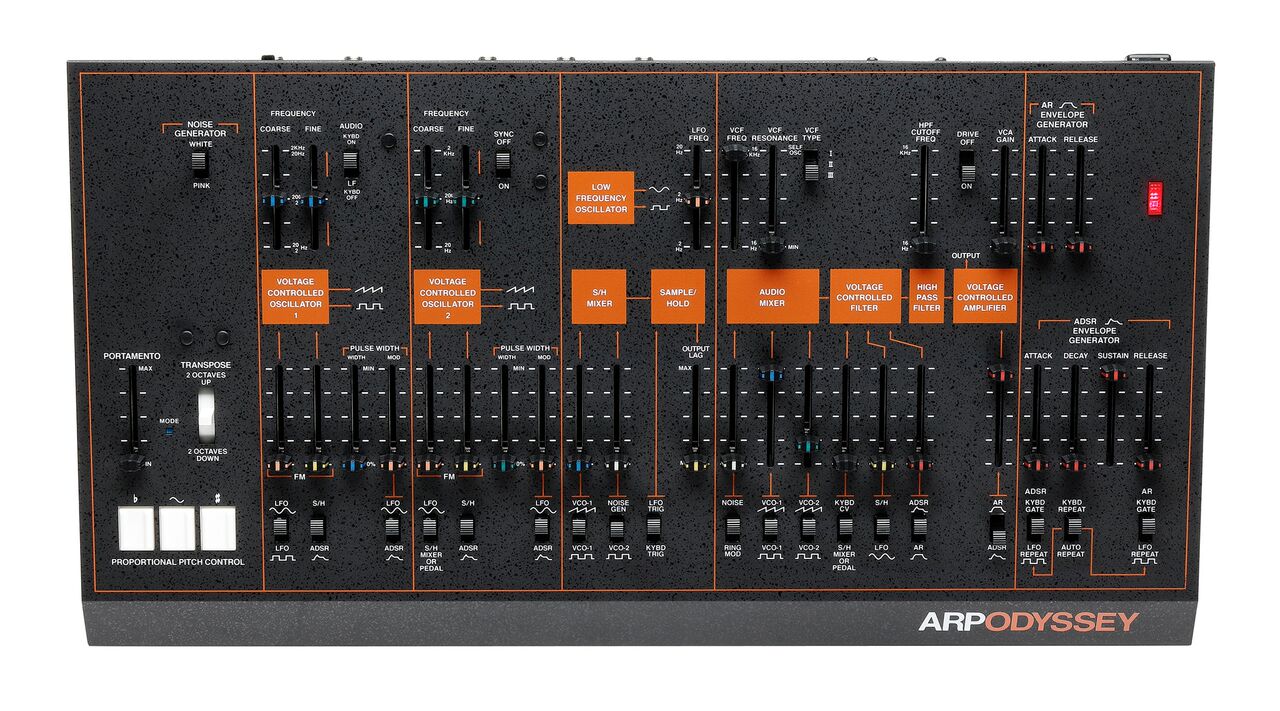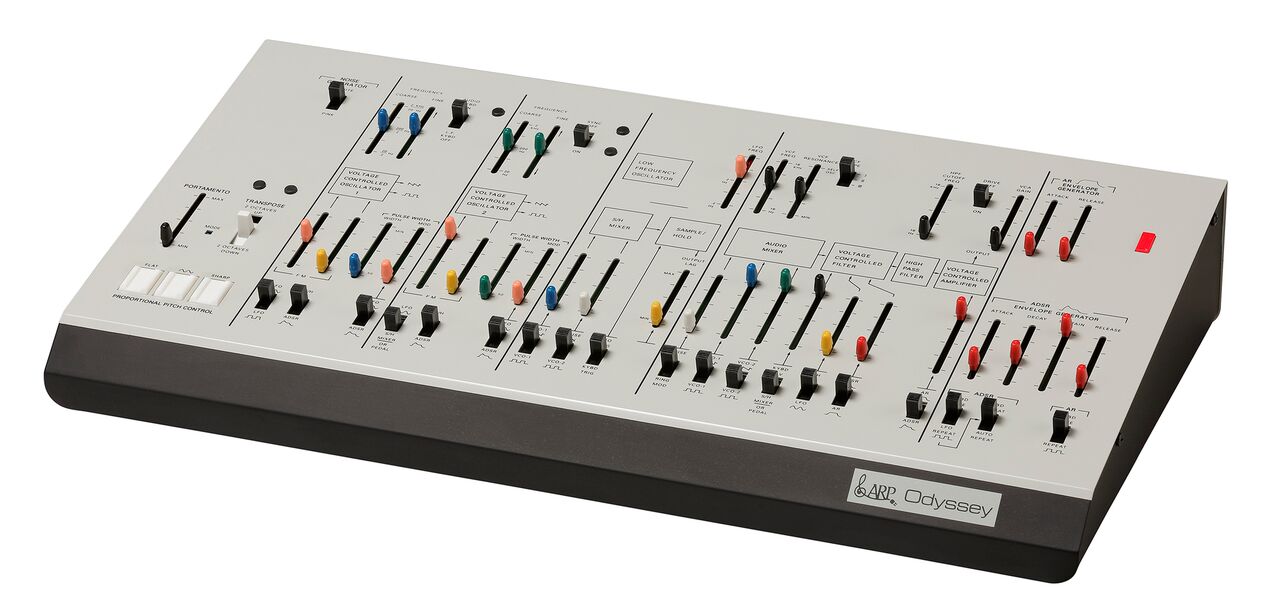Korg has officially announced two new ARP Odyssey modules that offer the classic sound of the legendary ARP Odyssey in a desktop module format.
The Korg ARP Odyssey Modules offer all the editing and sound-shaping parameters from the keyboard versions, but in a format designed to fit into DAW and hardware-centric music production environments.
The compact module form factor has both CV/GATE to interface with analog desktop racks and synths, and USB and 5-pin MIDI for interfacing with controllers and DAWs.
The lineup includes two models, the white Rev1 and the black and orange Rev3, reproducing traditional styling.
Since its appearance in 1972, the ARP Odyssey has earned its reputation as a classic analog synthesizer. Forty years later, in 2015, with the advisory assistance of David Friend, co-founder of the ARP Instruments company, Korg resurrected the ARP Odyssey with a complete reproduction of the ARP Odyssey’s original circuitry. With the new Odyssey Module, Korg has further broadened the reach of the classic ARP Odyssey design.
Video Intro:
Audio Demos:
ARP ODYSSEY Module Specifications:
Maximum Polyphony – 2 voices for duophonic; normally monophonic
Controllers –
Transpose Positions: 2 octaves down, normal, 2 octave up
Proportional Pitch Control:
b (Pitch down) Pad: about – 2 / 3 octave
– (Modulation) Pad
# (Pitch-up) Pad: about +2 / 3 octave
Noise Generator – Noise Spectrum Types (white and pink)
Portamento –
Maximum Speed: about 0.01 msec./oct
Minimum Speed: about 1.5 sec./oct
VCO (Voltage Controlled Oscillator)
Waveforms:
Sawtooth, Square, Pluse (Dynamic Pluse)
Frequency Range:
VCO-1 in low freq. mode, 0.2 Hz – 20 Hz: VCO-1 and VCO-2 (audio range) about 20 Hz – 20 kHz
Warm Up Drift:
1/30 semitone from turn on max
Pulse Width:
50 % – 5 %
Pulse Width Modulation:
ADSR, +45 %; LFO, +15 %
Voltage Controlled Response:
1 V/oct
Maximum Frequency Shifts:
LFO sin wave, +1/2 oct.; LFO square wave, +1.5 oct.; ADSR, +9 oct.; S/H, +2 oct.
* VCO-1 is low note priority, VCO-2 is high note priority.
VCF (Voltage Controlled Filter)
Types:
Low pass (I: 12 dB/oct., II III: 24 dB/oct.)
Frequency Range:
16 Hz – 16 kHz
Maximum Usable Q:
30
Resonance:
1/2 – self oscillate
Voltage Controlled Response:
C3 key (left edge): 0 V, C6 key (right edge) 3 V
VCA (Voltage Controlled Amplifier)
Dynamic Range:
80 dB
Ring Modulator
Type:
Digital
Input Signal:
VCO-1, VCO-2 (square wave)
Sample & Hold
Command Sources:
Keyboard or LFO trigger
Sampled Signals:
VCO-1 sawtooth wave and square wave, VCO-2 square wave and pink noise
ADSR Envelope Generator
Attack Time:
5 msec. – 5 sec.
Decay Time:
10 msec. – 8 sec.
Sustain Level:
0 – 100 % or Peak
Release Time:
15 msec. – 10 sec.
AR Envelope Generator
Attack Time:
5 msec. – 5 sec.
Release Time:
10 msec. – 8 sec.
Control Input Jacks
Pedal:
6.3 mm monaural phone jack
Portamento Foot Switch:
6.3 mm monaural phone jack
Audio Output Jacks
LOW:
Connector:
6.3 mm monaural phone jack
Maximum Output Level:
-20 dBu@ 10 k ohm load
Output Impedance:
10 k ohm
HIGH:
Connector:
XLR connector
Maximum Output Level:
+4 dBu@ 1 k ohm load
Output Impedance:
330 ohm
Headphones Jack
Connector:
6.3 mm stereo phone jack
Maximum Output Level:
50 mW + 50 mW@ 33 ohm load
Output Impedance:
10 ohm
* Controllable by volume knob.
External Audio Input (Ext Audio Input) Jack
Connector:
6.3 mm monaural phone jack
Maximum Input Level:
-10 dBu
Input Impedance:
22 k ohm
MIDI Connector
IN
USB Connector
Type B
CV IN/OUT Jacks
Keyboard CV (IN/OUT):
1 V/oct.
Connector:
3.5 mm monaural phone jack
GATE IN/OUT Jacks
GATE IN:
+3 V (minimum)
GATE OUT:
+10 V, key down; 0 V all keys up
Connector:
3.5 mm monaural phone jack
TRIG IN/OUT Jacks
TRIG IN:
+3 V pulse min., 10 ?sec. Duration minimum
TRIG OUT:
+10 V pulse on key depression, 10 ?sec. Duration
Connector:
3.5 mm monaural phone jack
Power Supply
AC adapter jack (DC 9V)
Power Consumption
6.5 W
Dimensions (W x D x H)
502 x 230 x 120 mm / 19.76” x 9.05” x 4.72”
Weight
4.5kg / 9.92 lbs.
Included Items
AC adapter, phone cable, mini-phone cable
Accessories
Expression/Volume Pedal:
XVP-20
Volume Pedal:
VP-10
Pedal Switch:
PS-3
Pedal Switch:
PS-1
Pricing and Availability
The Korg ARP Odyssey Module Rev 1 and Rev 3 will be available October of 2016 for $599.99 (US) each. For more information or to find a dealer, visit www.korg.com











Now I’m interested. 599 I like the sound of a that.
Maximum Polyphony – 2 voices for duophonic; normally monophonic… this is so 1970´s.. why??
Monophonic because it has an analog signal path. Polyphonic analog/hybrid synths require lots of digital to analog converters.
Monophonic because it means that the knobs and switches are connected directly to the sound generating circuit. No latency. No digital quantization.
Monophonic because it’s a modern reissue of an instrument that was first released in 1972.
Yeah, there’s a reason digital technology took over from analog for poly synths. Digital is the sweet spot for poly and analog is the sweet spot for mono. There will always be exceptions, of course, but the economics of poly encourage digital solutions.
thanks!!!! Gracias!!!!!!
Time to sell my Minitaur. This will be far more versatile for my needs.
Hmmm … the Minitaur has a really heavy thick sound you may not get out of the Arp/ Korg.
“may not get” is pretty generous.
this upsets me. could they not have done this from the start? or do i just have to wait two years every time a synth i want comes out to hope a module version is announced. anyway, i will still probably be getting one. not anytime soon though.
This all things retro has simply become regressive, when company’s are spending their resources, and exercising their R&D prowess to reach some 40 years back and give users actually nothing new. It’s akin to any other industry reprising old technology to address modern challenges. Perhaps Apple should reprise the IIc and Microsoft reintroduce DOS.
Ah jesus christ, if you can’t think of anything new and creative to do with a piece of kit like this then don’t bother with trying to sound so concerned about the future of music.
Because it’s not a phone or a laptop, it’s a musical instrument. Why do people ask this question about synthesisers and not string or percussion instruments? Just because electricity passes through its circuits doesn’t mean the design becomes obsolete or needs to be reinvented to be relevant.
You’re missing the point Brian. Synthesis and its genesis represented the future, at least it still does for me. This sort of regressive renaissance runs counter to the notion from my vantage point.
I like what Berhinger is doing, not because of the price point, yet because it is progressive, it is moving the science and art-form forward. I really like my Modal synths. This to me represents in many ways the worst of mankind’s infatuation with yesteryear.
I’m missing ‘the’ point, or ‘your’ point? It seems you need a synthesizer to push the boundaries of technology to be relevant. I think it needs to sound great and be used to create amazing music to be relevant. The analogue era of the 70’s and early 80’s was only ever available to the masses for a very brief time before digital synths happened. So that technology was never fully explored at the time of its creation. Today we can pair up analogue synths with 21st century computers and do things the likes of Kraftwerk could only have dreamed of. But are we hearing music as good as some of the great electronic music of that era? Some is amazing, some isn’t, but that’s not defined by the technology, it’s defined by the talent. However, much of the more interesting electronic music being made today is being made by people using analogue synths, some of them crazy enough to use vintage synths created before the silicone chip!
Your Modal is very nice I’ve no doubt. The Deepmind is a tarted up Juno 106, so I’m not sure how that is necessarily a huge leap forward. But the point is, just like guitars, cellos, and pianos, the synthesizer had already been invented. It doesn’t need to be reinvented. It can be expanded upon and taken to new places, but all previous versions of the synthesizer remain as valid as all previous versions of traditional instruments. And continuing to make synths based on 40 year old technology is a beautiful thing. It means someone created something 40 years ago that has remained valid for decades. What’s wrong with that? Not everything should be replaced after 18 months.
Brian,
I don’t replace everything every 18 months, your not so subtle slights haven’t gone unnoticed, it seems you tie your relevancy as much into something created 40 years as I tie the relevancy of progress vs relics. Just as much one needn’t replace their collection of synths every 18 months, it seems equally as absurd to reissue something from 40 years ago!
I design and build synths for a living, perhaps a different perspective, yet I will never reissue something I built even 10 years ago, let alone 40.
Some people want certain pieces of gear for certain reasons, wether they be based on the sound, the aesthetic or nostalgia and its fantastic that korg and now roland are realizing this because for most of us the originals are way outta reach. If you are talking about the future of music like such a pro than you would not be building synths at all, that alone is a relic idea, you would be working directly in Max, Puredata or the like and constructing way beyond the means of the new hobbyist modular subculture. It’s not the tools it’s what you do with them boys.
Verra, just a point, MAX is based on essentially PureData architecture, it simply has a more sophisticated UI.
Cheers
And this conversation’s “Well Actually” award goes to… Sphere6!
Ha, yes. Wasn’t it just a short 3-4 years ago that everyone was clamoring for Korg, Roland to financing once again and reissue old synths?
Funny how quickly that tune is changing.
I mean, I’ll gladly take this stuff over a Korg R3 but to each their own.
Ha, yes. Wasn’t it just a short 3-4 years ago that everyone was clamoring for Korg, Roland to realize what everyone wanted – to reissue old analog synths?
Funny how quickly that tune is changing.
I mean, I’ll gladly take this stuff over a Korg R3 but to each their own.
The argument of why to re-release/re-issue is completely irrelevant to music making. You can still make music with newer technology, then touch up some bass frequencies with a nice Moog or arp (because it’s your right to make music however you feel).
In addition to saying it’s absurd for a company to re-issue an instrument….. Fender has been KILLIN THE GAME with stratocasters, telecasters, jazzmasters.. I could keep going.
Part of the issue is price point as well. I could have never afforded the forty year old version, nor would I want to lug one around, or worry about it going out of tune. Now this I can afford, and move to gigs easily, and I would be surprised if they didn’t engineer it to be more reliable.
Pretty much every polysynth with at least one DCO, a sub-osc, a VCF and VCA, an envelope and an LFO is a “tarted up Juno 106”.
And the 106 was a slightly less interesting Juno 60.
Same reason why Fender keeps making Stratocasters. If you have ideas for completely new, paradigm-shattering instruments you should totally make them. In the mean time, the rest of will keep making music on well-designed, great sounding instruments that are being offered at reasonable prices.
Ye olde adage:
It’s not what you have, it’s how you use it.
Also, the sounds are still relevant and are great.
Good luck finding an original ARP Odyssey in playable new condition for an affordable price. Korg is restocking the market with a successful instrument for people to use.
Don’t like it? Don’t buy it.
New such as “new English” where “spelling don’t matter no more”. Company’s… yeh sure… or maybe even companys or companyz.
There are plenty of new digital synths and software synths out there.
Should we then stop the production of pianos, violins and all other acoustic instruments because these are “old”?
The combination of different music instruments is what gives colour to a piece of music.
Today we have a great choice between digital and analogue instruments, old and new. Thumbs up for that!
Nice, I can live without the keys and control it from external midi keyboard
And the price also speaks
My thoughts exactly. What keyboard are you going to use?
Yessss. Will fit in nicely.
I’m starting to save money for this. Thanks Korg!
I really really hope this last flogging means the 2600 is round the corner
I’m wondering if the ending of the TTSH project was related to an upcoming 2600 re-issue. It also may be he got tired of selling them, but it seems like the pcbs sold out every time…
great price no doubt about that
Bellissimo Synthesizer i suoni sono veramente ottimali. E’ una macchina con la quale si possono creare sonorità infinite e ineguagliabili. Non Sarebbe male aggiungerci un Sequencer – Memorie per memorizzare Suoni che si creano – Ed inoltre un processore di effetti. Ma vi assicuro che è già bella così. Contattatemi se volete acquistarla.
Beautiful synthesizer sounds are really optimal. It ‘a machine with which you can create endless sound and unparalleled. It would not hurt to add us a Sequencer – Memories to store sounds that you create – And also an effects processor.
But I assure you that is already pretty well.
Contact me if you want to buy it.
Bye Mycol.
http://www.logicmusicstudios.com
ID Skype: logic.music.studios
Fettuccine, Alfredo
Fuck me.
Your website is an abomination.
does it respond to pitch bend and modulation over midi?
Looks like it was scaled down from mini keys to mini knob/sliders Boutique style. Been waiting 2 years for this (why Korg? ) Now I wonder, why did Korg not use those 2 years to create one with full CC control. Just a matter of adding a simple processor and digital pots among other logic. Indeed it would push up the price a bit, but no CC control is a bit out of date folks.
Adding cc control would not be simple, and the additional control circuitry would likely change the sound. It is the kind of significant design effort that is best planned for in the beginning, not tacked onto a 40 year old desgn.
CC would not be fun as midi controllers with a lot of knobs are not available. And I would like one that has MANY knobs for CC control.
Imagine a big (for example 61-key) controller running the module. That would be so fun!
x-mas list just got complicated
Lack of MIDI cc still a major bummer. But hands on knobs and faders make up for that a bit.
I assume controlling various functions via CV would be possible with some mods, just like with any all-analogue gear.
Probably. But then your into cutting the panel. Shame they didn’t add a patch bay to the front. Would have been a terrific addition to this synth.
still no cc… Deal breaker for me.
Sorry Korg, no cc, no money !
Would’ve been nice to have all the patch points on the face á la SEM or Mother 32… key aesthetic in desk top gear for me
Not in the market for this as I’m well supplied with monosynths, but I must say I find that white livery very beautiful.
Hey hey …. I bought an Axxe years ago because I couldn’t afford an Odyssey.
Now I can link this up and play it from my Axxe. If you know your ARP history you’ll know about the “Little Brother” which I always wish I’d bought…
Now I’ll have an “Extra Big Brother” for my Axxe…. Thank you Korg.
The white one looks cool.
Take my money.
Deepmind 12 polyphonic module or Arp monophonic?
The Arp looks cooler, but I sure like the full chord sounds on the DM12.
I like this. I always feel a bit scared when using the original. It would be nice to switch to a new clone and only use the original a few times a year, to prevent the caps from disintegrating.
I really liked Korg’s first take, but I don’t need the keyboard and prefer to use my own MIDI to CV designs. So this version makes more sense for me.
if this was rack-mountable it would be a no-brainer purchase for me, but it’s about an inch too wide. What’s particularly frustrating is that about 1-2 inches are wasted on the left with the pitch bend pads – why?
I still really want it but I have no idea where I’d put it.
If Korg gives me a free one, I will give them a slight discount on my endorsement fee.
This looks pretty interesting, except they kept the pads on the lower left corner of the unit. They couldn’t have been stupid enough not to have let the unit receive incoming pitch bend and modulation midi messages could they?
But does it come with that fancy carrying case?
I hope it comes with the shown carrying case too. Music is really getting too many inputs these days which isn’t fraud free too.
It’s akin to any other industry reprising old technology to address modern challenges
its all depend on you how you do it
Great keep it up!